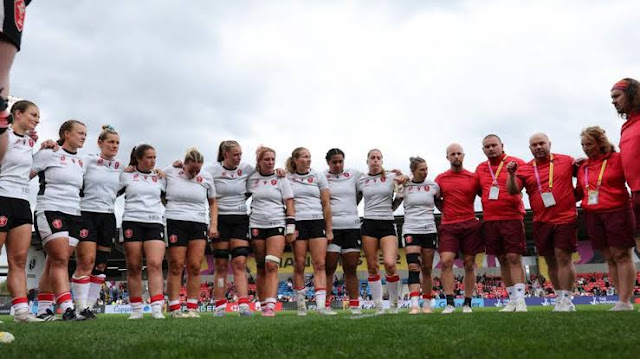In a display of sheer dominance, Canada’s women’s rugby team solidified their status as one of the leading contenders for the 2025 Women’s Rugby World Cup, securing a quarterfinal berth with a game to spare after a resounding 42-0 victory over Wales in their Pool B clash in Salford on Saturday, August 30, 2025. The match, characterized by Canada’s relentless set-piece dominance and expansive attacking play, saw them follow up their 65-7 thrashing of Fiji with another emphatic performance. For Wales, the defeat pushed them to the brink of elimination, compounding the disappointment of their earlier 38-8 loss to Scotland. With Scotland facing Fiji later that day, any match points for the Scots would confirm Wales’ exit from the tournament.
Early Exchanges and Canada’s Growing Dominance
The match began with Wales showing early promise, bringing physicality and intent to the contest. For the first 15 to 20 minutes, they challenged Canada with aggressive carries and tenacious work at the breakdown, forcing the second-ranked team in the world (behind England) into a defensive scramble. Wales’ early pressure tested Canada’s resolve, as they sought to build on the physicality that had been a hallmark of their game plan. However, Canada’s forwards, renowned for their set-piece prowess, soon asserted control, turning the tide decisively in their favor.
The turning point came as Canada’s scrum and lineout began to dominate. Props McKinley Hunt and Brittany Kassil anchored a formidable front row, consistently winning penalties and turnovers at the scrum. This set-piece dominance provided Canada with a steady stream of possession and territorial advantage, allowing their backline to unleash wave after wave of attacking plays. By the half-hour mark, Canada had seized control, racing to a 28-0 lead that effectively ended the match as a contest. McKinley Hunt was a standout performer, powering over for two tries that showcased her strength and determination. Her first try came from a well-executed forward drive, while her second was a testament to Canada’s ability to capitalize on quick ball from the set-piece.
Wings Alysha Corrigan and Asia Hogan-Rochester added flair to Canada’s attack, each crossing the try line in the first half. Corrigan’s try was a product of Canada’s expansive play, as she exploited space on the flank with her pace and agility. Hogan-Rochester, equally clinical, finished off a flowing move that highlighted the seamless interplay between Canada’s forwards and backs. These tries not only extended Canada’s lead but also underscored their ability to combine physicality with attacking ambition, a hallmark of their game plan under head coach Kevin Rouet.
Second Half: Canada’s Clinical Finish
The second half saw Canada maintain their stranglehold on the match, even as Wales showed signs of improvement. Flyhalf Taylor Perry and prop Brittany Kassil added to the scoreboard with tries that further demonstrated Canada’s depth and versatility. Perry’s try came from a smart read of the game, as she inserted herself into the attacking line at the perfect moment to breach the Welsh defense. Kassil’s score, meanwhile, was a reward for her tireless work in the tight exchanges, as she powered over from close range to cap another dominant forward effort.
A significant moment in the second half came when Wales’ Georgia Evans was shown a yellow card, leaving her team temporarily reduced to 14 players. Canada capitalized on their numerical advantage, maintaining their attacking momentum and preventing Wales from gaining a foothold. Lock Sophie de Goede, one of the stars of the match, was flawless with her kicking, converting all six tries in a perfect display off the tee. Her accuracy and composure ensured that Canada maximized their scoring opportunities, building an unassailable lead that reflected their dominance across all facets of the game.
De Goede’s contribution extended beyond her kicking. As a key figure in the lineout, she helped Canada maintain a strong platform for their attacking plays while disrupting Wales’ throws. Her work rate in the loose, combined with her leadership on the field, made her a central figure in Canada’s commanding performance. Captain Alex Tessier, reflecting on the match, praised the team’s set-piece dominance, telling the BBC: “I think we were very dominant in the set-piece, it was amazing to watch our girls dominate the scrums and the line-out was still strong for us. We knew what to expect from Wales, we knew they were going to be physical, especially around those breakdowns, which we didn’t react quickly enough, but we kept our composure and managed to score back-to-back tries.”
Wales’ Struggles and Glimmers of Hope
For Wales, the match was a stark reminder of the challenges they face against top-tier opposition. Already reeling from a surprisingly heavy 38-8 defeat to Scotland in their opening match, Wales entered the game without their injured co-captains, Alex Callender and Kate Williams, whose absence was keenly felt. Despite their early promise, Wales struggled to maintain consistency, particularly at the set-piece, where Canada’s forwards overwhelmed them. The Welsh pack, while physical, could not match the power and precision of their Canadian counterparts, and their lineout faltered under pressure.
Wales did show signs of improvement in the second half, particularly in their attacking ambition. They made several promising entries into Canada’s 22-meter zone, moving the ball with greater intent and threatening to breach the Canadian defense. However, each time they came close, they were either repelled by Canada’s resolute tackling or let down by handling errors and poor decision-making. These mistakes proved costly, as Canada’s ability to absorb pressure and counterattack kept Wales pinned back for much of the game.
Welsh coach Sean Lynn acknowledged the team’s improved performance compared to their opening loss, noting the physicality and bravery shown in parts of the match. “In the first 15 to 20 minutes we could see the physicality side of it, I saw improvements, and that’s what I wanted,” Lynn told reporters. “When I went in at halftime, I told the girls, ‘just empty those tanks in the next 40 minutes.’ The big thing for me was that in the last 15, 20 minutes there was a glimpse of what I want to see, being brave, moving the ball and getting individuals with the ball in hand.” Despite these glimmers of hope, the 42-0 scoreline highlighted the gap between Wales and the tournament’s elite teams, and their hopes of advancing now hinge on the outcome of Scotland’s match against Fiji later on Saturday.
Canada’s Path to the Quarterfinals
Canada’s victory was not just a statement of their attacking prowess but also a reflection of their strategic discipline and defensive resilience. Their ability to weather Wales’ early storm and then impose their game plan was a testament to their preparation and composure. The 42-0 win, coupled with their 65-7 demolition of Fiji in their opening match, gives Canada 10 points from two Pool B fixtures, putting them in a strong position to finish in the top two and secure a quarterfinal place. As the 2014 World Cup silver medalists, Canada is rediscovering the form that made them a force in women’s rugby, and their performance in Salford will serve as a warning to their rivals.
The match also highlighted Canada’s depth and versatility. From the power of Hunt and Kassil in the front row to the flair of Corrigan and Hogan-Rochester on the wings, Canada demonstrated a balanced and cohesive team effort. Sophie de Goede’s flawless kicking and leadership in the forwards, combined with Taylor Perry’s playmaking in the backline, underscored the team’s ability to execute a multifaceted game plan. Their set-piece dominance, expansive attacking play, and resolute defense make them a formidable opponent as they look ahead to the knockout stages.
The Broader Tournament Context
While Canada’s victory was the headline act in Pool B, Saturday’s other matches in Pool A added further intrigue to the tournament. Tournament favorites England, fresh off a 69-7 thrashing of the United States, faced Samoa with a heavily rotated squad, making 13 changes to their starting lineup. Despite the changes, England was expected to book their place in the quarterfinals with another commanding performance. Meanwhile, the United States, licking their wounds after their loss to England, took on an Australian team buoyed by a 73-0 rout of Samoa. These matches underscored the competitive nature of the tournament, with top teams asserting their dominance while others fought to keep their hopes alive.
Looking Ahead
For Canada, the focus now shifts to their final pool match and the quarterfinals, where they will aim to build on their impressive performances. Their blend of physicality, skill, and tactical nous makes them a genuine contender for the title, and their ability to execute an expansive game plan while maintaining defensive solidity will be key to their success in the knockout stages. For Wales, the defeat to Canada was a sobering experience, but the improvements shown in the second half offer a foundation to build on. With their tournament hopes hanging by a thread, the Welsh coaching staff will look to regroup and prepare for future challenges, using this match as a learning opportunity.
In conclusion, Canada’s 42-0 victory over Wales was a masterclass in modern rugby, combining set-piece dominance, expansive attacking play, and clinical finishing. McKinley Hunt, Alysha Corrigan, Asia Hogan-Rochester, Taylor Perry, Brittany Kassil, and Sophie de Goede were among the standout performers, each contributing to a comprehensive team effort that left Wales with little room to maneuver. As Canada marches toward the quarterfinals, their performance in Salford will resonate as a statement of intent, while Wales faces an uncertain future in the 2025 Women’s Rugby World Cup.






